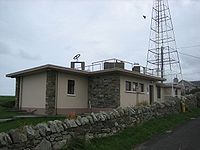Malin Head: Difference between revisions
m Rm spam/foreign language site |
|||
| Line 32: | Line 32: | ||
==References== |
==References== |
||
<references/> |
<references/> |
||
==External links== |
|||
*[http://www.360eire.com/360eire/Uladh/DunnanGall/iniseoghan/malinhead/CionnMhalanna.html 360 View of Malin Head] |
|||
[[Category:Meteorological stations]] |
[[Category:Meteorological stations]] |
||
Revision as of 21:19, 31 December 2011

Malin Head (Template:Lang-ga), on the Inishowen Peninsula, County Donegal, is usually given as the most northerly headland of the mainland of Ireland (it is not in Northern Ireland, though more northerly than any part of it). In fact, the most northerly point is actually a headland named Banba's Crown on the Inishowen Peninsula about 2 km (1 mi) to the northeast. Malin Head lies at latitude 55.38ºN.[1] Malin Head gives its name to the Malin sea area. There is a weather station on the head.
Banba's Crown on Malin Head is the most northerly point of the Irish mainland.[2] Banba was one of the mythical queens of Ireland. Banba's Crown is about 16 km (10 mi) north of the village of Malin. The island of Inishtrahull is further north, located approximately 10 kilometres north east of Malin Head. Further north still is the most northerly landfall of Ireland, Tor Beg rock.
Locality
To the north-east Inistrahull Island can be seen . The first lighthouse on the island was put into operation in 1813, and the light flashes every 30 seconds.
Above Banba's Crown to the east lies Ballyhillion beach, a unique raised beach system of international scientific importance.[citation needed] The very distinct shorelines show the changing relationship between the sea and the land from the time the glaciers began to melt, some 15,000 years ago. At that time County Donegal was depressed by the weight of an immense ice sheet, so the level of the sea, relative to today's shore, was up to 80 feet higher than today.
Wartime use

During WWII, the Irish Government allowed the British to site two radio direction finders on the head. This top-secret operation was mentioned in the The Cranborne Report. The RDF equipment was used to monitor U-Boat and aerial activity in the North Atlantic.
After the war, the site became a weather station for the Irish Meteorological Service.
Ornithology
Malin Head is one of the few places in Europe where the elusive Corn Crake can be heard. It is also an ideal vantage point from which to view the Autumnal movements of seabirds such as gannets, shearwaters, skuas, auks and others, on their southward migration flights.
55°23′N 7°22′W / 55.383°N 7.367°W
Gallery
-
View of the rugged coast around the Head.
-
Low tide beneath the cliffs at Malin Head.
See also
References
- ^ "Ireland Geographical Facts, Figures and Physical Extremities". Travel through the Ireland story... Retrieved 2007-09-15.
- ^ "See Ireland's most northerly point at Malin Head". Brilliant Ireland. Archived from the original on March 27, 2009.


